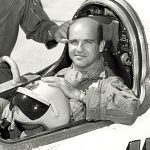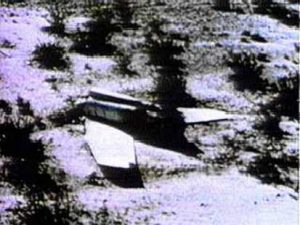 For years after the first planes began to fly, aviators knew that they would eventually go faster and faster. I’m not sure who first came up with the idea of flight at Mach speed, but it was a challenge that the test pilots quickly set their sights on. Test pilots are a notoriously reckless bunch. They know that the planes and speeds they test could get them killed, but they do it anyway, trying to beat the odds. The first Mach 1 flight (documented anyway, since several other pilots claimed to have done it) was Luftwaffe test pilot Lothar Sieber (April 7, 1922 – March 1, 1945) who broke the sound barrier inadvertently on 1 March 1945. At the time, he was piloting a Bachem Ba 349 “Natter” for the first manned vertical takeoff of a rocket in history. In just 55 seconds, he traveled a total of 8.7 miles. The aircraft crashed and he was killed. Serious thought would have to be give to stability at that speed, and the improvements were started immediately. Still, it would take time before anyone dared to try it again.
For years after the first planes began to fly, aviators knew that they would eventually go faster and faster. I’m not sure who first came up with the idea of flight at Mach speed, but it was a challenge that the test pilots quickly set their sights on. Test pilots are a notoriously reckless bunch. They know that the planes and speeds they test could get them killed, but they do it anyway, trying to beat the odds. The first Mach 1 flight (documented anyway, since several other pilots claimed to have done it) was Luftwaffe test pilot Lothar Sieber (April 7, 1922 – March 1, 1945) who broke the sound barrier inadvertently on 1 March 1945. At the time, he was piloting a Bachem Ba 349 “Natter” for the first manned vertical takeoff of a rocket in history. In just 55 seconds, he traveled a total of 8.7 miles. The aircraft crashed and he was killed. Serious thought would have to be give to stability at that speed, and the improvements were started immediately. Still, it would take time before anyone dared to try it again.
Now, the pilots set their sights on the next big dream…Mach 2. It was always a race to be the first to achieve it. Flying at Mach 2 was not going to be very far behind Mach 1. On November 20, 1953, Albert Scott Crossfield became the first person to fly at twice the speed of sound as he piloted the Skyrocket to a speed of 1,291 mph…Mach 2.005. The Skyrocket proved to be of a superior design, and after the record breaking flight, Crossfield was able to safely land the plane. He was not only successful in flying at Mach 2, but he was able to enjoy the victory celebration afterward, and in the world of Mach speed flying, that was a novelty for sure.
 As with any other milestone, records such as Mach 2 flying are just meant to be broken. Mach 3 was the new challenge, and the breaking of this record would come even quicker than the last one had. On September 27, 1956, Milburn G. Apt, flying in the Bell X-2. The plane, which had been nicknamed Starbuster was an X-plane research aircraft built to investigate flight characteristics in the Mach 2–3 range. Apt was a Unites States test pilot, and his specialty was high speeds. He was shooting for and attained the record breaking speed of Mach 3.196 on that fateful September day, but did not live to receive the praise for his accomplishments. The subsequent loss of control of the plane from inertia coupling led to the breakup of the aircraft and Captain Apt’s death.
As with any other milestone, records such as Mach 2 flying are just meant to be broken. Mach 3 was the new challenge, and the breaking of this record would come even quicker than the last one had. On September 27, 1956, Milburn G. Apt, flying in the Bell X-2. The plane, which had been nicknamed Starbuster was an X-plane research aircraft built to investigate flight characteristics in the Mach 2–3 range. Apt was a Unites States test pilot, and his specialty was high speeds. He was shooting for and attained the record breaking speed of Mach 3.196 on that fateful September day, but did not live to receive the praise for his accomplishments. The subsequent loss of control of the plane from inertia coupling led to the breakup of the aircraft and Captain Apt’s death.


2 Responses to Mach 3 And Down